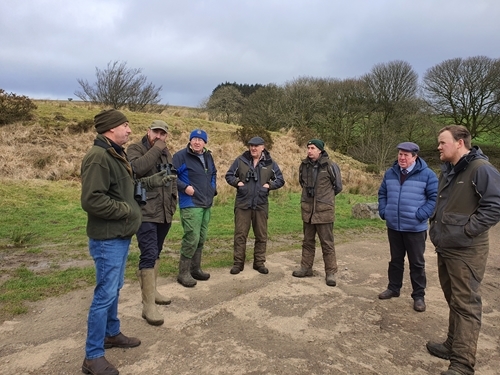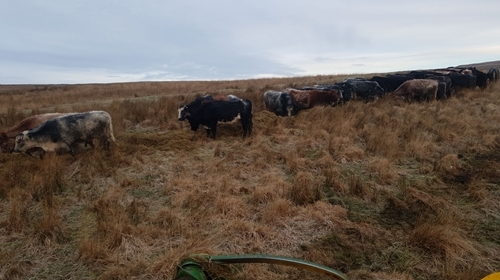
Brian Bowen is the Farmers' Union of Wales Vice President for mid-Wales. He has a 230 suckler breeding herd and over 1200 sheep which grazes the three commons that surround his farm in Blaenau Gwent, South East Wales.
He believes that not only do the cows break up the vegetation to create a more diverse habitat for different species to nest and feed in, but poaching of the ground with their feet also creates water capture which again is another habitat to attract more wildlife.
“My cows and sheep are integral to boosting wildlife,” says Mr Bowen, who hosted a Big Farmland Bird Count this week at Pencoedcae Farm, Princetown, near Tredegar.
“It also provides access by breaking up the vegetation to the vast numbers of people who visit the area,” he says, pointing to the Brecon Beacons which the ground extends to. Infact Brian is surrounded by Common land which is used by many people with different interests as well as it being critical to the farming enterprise.
Neighbouring farmers to Brian are also breeding cows along with sheep in these peat rich hills which are storing millions of tonnes of carbon, using the native breeds - Galloway and Welsh Blacks for example - which are hardy and flourish in its harsh conditions of high altitude and rainfall.
“It requires a special breed of cow here which is the cornerstone for the lowland breeders,” says Brian, who describes the native breeds as being tough but stresses that their contribution to the health of the moorland is poorly understood, and the threat of a TB outbreak to all Welsh cattle farmers is a constant worry.

Matt Goodall from the Game & Wildlife Conservation Trust Wales presented to the group of farmers and neighbours on why all farms need to think about birds at this time of the year in particular.
Known as the ‘hungry gap’, birds are struggling to get enough food to reach breeding condition, he explains, emphasising that small changes to certain areas of the farm can really boost birdlife and give untold benefits, he adds.
“Tidy farms and the loss of spring cropping across Wales means that little seed is available on our pasture farms as we have moved away from mixed farming on the whole over the past 30 odd years,” says Matt
“Farms can help by growing a strip of wild bird seed mix for example, at the field margin, or provide a feed hopper or two if they have brassica forage crops,” he adds.
“These small additions can really make a difference and will provide plenty of nutritious bird food,” stresses Matt, who suggests managing hedgerows by keeping stock out of the base and increasing their size so that birds are well protected and not spending their energy keeping warm.
Finally Matt encourages as many farmers as possible to get involved in the Big Farmland Bird Count from this Friday to the 16th of February.
“It’s a great and easy way of getting a baseline of the birds present and to monitor it each year to see how the small changes affect your bird life.”
How to take part: Download a count sheet from www.bfbc.org.uk and count your birds! On a day between February 7 and 16, spend about 30 minutes recording the species and number of birds seen in one particular area, aiming for approximately 5 acres. Once completed, submit results at www.bfbc.org.uk
Several identification workshops will be taking place throughout Wales at the end of January to help sharpen up bird recognition skills and act as a dry run before the BFBC begins on Friday 7 February. Please view our website www.gwct.org.uk/wales to see what event is taking place near you.
Notes to editors
The Game & Wildlife Conservation Trust – providing research-led conservation for a thriving countryside. The GWCT is an independent wildlife conservation charity which has carried out scientific research into Britain’s game and wildlife since the 1930s. We advise farmers and landowners on improving wildlife habitats. We employ more than 60 post-doctoral scientists and other research staff with expertise in areas such as birds, insects, mammals, farming, fish and statistics. We undertake our own research as well as projects funded by contract and grant-aid from government and private bodies.
For information, contact:
Eleanor Williams
Telephone: 07592 025476
Email: press@gwct.org.uk